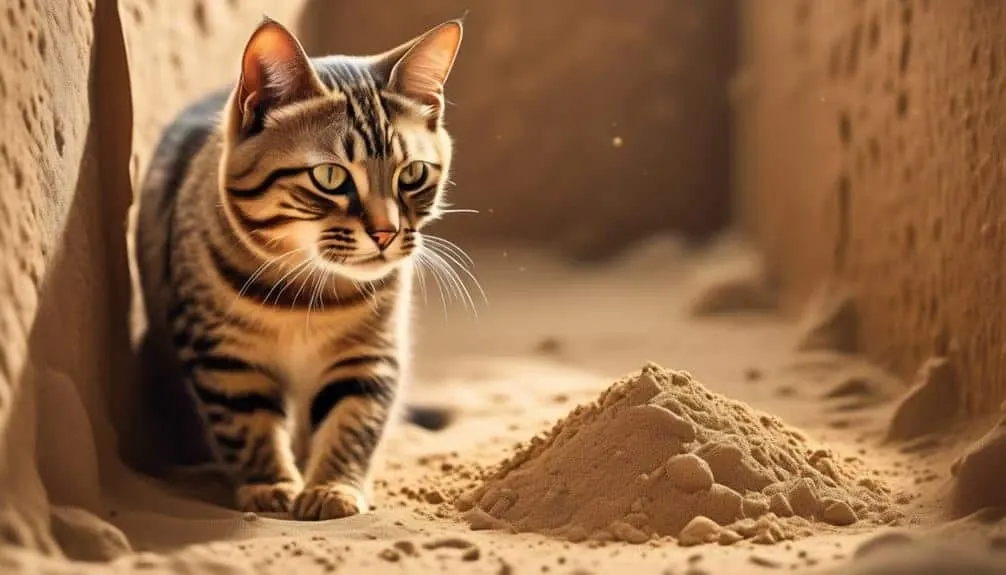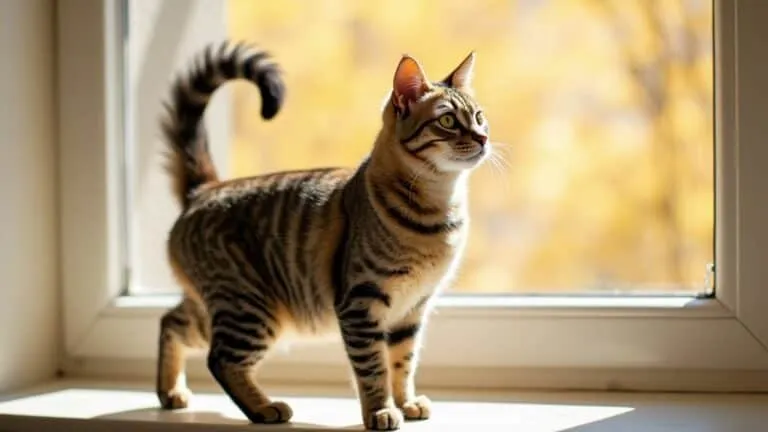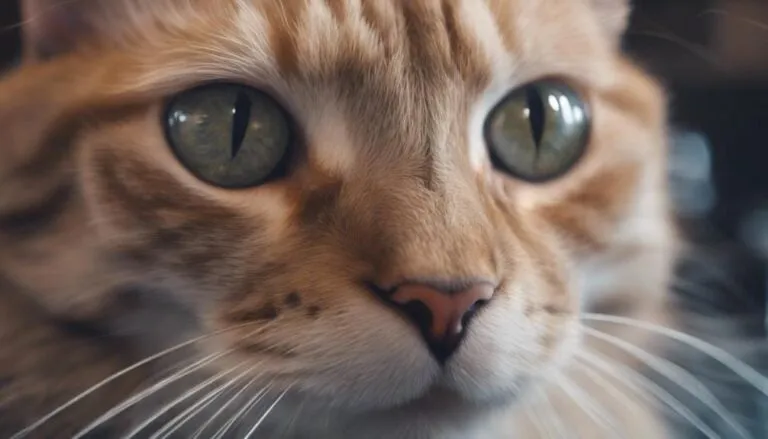The Best Fluffy Pancakes recipe you will fall in love with. Full of tips and tricks to help you make the best pancakes.

Have you ever noticed your cat vigorously scratching the sides of their litter box after doing their business? It may seem like a puzzling behavior, but there is actually a hidden meaning behind it. This behavior is instinctual and serves a purpose beyond just covering their waste.
By scratching the sides, cats are mimicking their natural instincts and preventing predators from tracking them down in the wild. But why do some cats have a routine of scratching the sides? And how can you address this behavior?
In this discussion, we will explore the reasons behind cats' litter box scratching, the factors to consider for a proper litter box setup, potential health issues related to this behavior, and possible solutions to help you and your feline friend.
So, let's uncover the mystery behind your cat's litter box scratching and discover the hidden meaning behind it.
Key Takeaways
- Cats scratch the sides of the litter box to cover their waste and mimic their natural instincts.
- Scratching the sides can help cats stretch their backs and sharpen their claws.
- Scratching the sides can be a way for cats to mark their territory and communicate with other cats.
- Health issues and environmental factors can influence litter box scratching, so it is important to address any underlying causes and provide appropriate solutions.
Reasons for Scratching the Sides
Cats instinctively scratch the sides of the litter box, exhibiting a behavior that serves a variety of purposes. Understanding cat behavior is crucial for preventing litter box accidents.
Scratching the sides helps cats cover their waste and mimic their natural instincts. It also prevents predators from tracking them down in the wild. The sound of scratching is inevitable due to the limited space of a litter box. Larger amounts of litter can minimize scratching on the sides.
Most cats scratch the sides unintentionally, helping them remove clumps of litter stuck between their toes. Some cats have a routine of scratching the sides after using the litter box, which can also help them stretch their backs and sharpen their claws.
Redirecting scratching behavior towards a scratching post is recommended.
Mimicking Natural Instincts
When observing a cat in their natural environment, one can't help but notice their instinctual behavior of scratching the sides of the litter box. This scratching behavior serves a purpose beyond just covering their waste. Here are four insights into why cats mimic their natural instincts through this behavior:
- Mimicking Predatory Behavior: Scratching the sides of the litter box helps cats mimic their natural instincts by preventing predators from tracking them down. In the wild, the sound of scratching would alert potential threats and give the cat an advantage to escape.
- Maintaining Cleanliness: Cats have high cleanliness standards and scratching the sides of the litter box helps them remove clumps of litter stuck between their toes. This behavior ensures that they're clean and comfortable after using the litter box.
- Stretching and Claw Maintenance: Scratching the sides of the litter box also helps cats stretch their backs and sharpen their claws. By mimicking their instinctual scratching behavior, cats can keep their muscles toned and their claws in optimal condition.
- Scent Marking: Cats release their scent through the scent glands on their paw pads, and scratching the sides of the litter box can be a way for them to mark their territory. This behavior is particularly common among unneutered or unspayed cats and cats sharing a litter box with others.
Understanding these instincts behind scratching behavior can help cat owners create a more enriched and satisfying litter box environment for their feline friends.
Preventing Predators in the Wild
To prevent potential predators from tracking them down, cats instinctively scratch the sides of the litter box. This behavior serves as a natural defense mechanism in the wild. By scratching the sides, cats create a barrier that masks their scent, making it harder for predators to locate them.
Additionally, this scratching action helps to prevent injuries that could occur from encounters with predators. Cats are intelligent creatures that use their instincts to protect themselves.
As a pet owner, you can support this behavior by providing a suitable litter box that allows for scratching without causing damage. Ensuring that the litter box is large enough and regularly cleaned can help prevent injuries and promote a safe and comfortable environment for your cat.
Sound of Scratching in Limited Space
As your cat scratches the sides of the litter box to prevent predators from tracking them down, you may notice the inevitable sound of scratching in the limited space. Here are some insights on this topic:
- Reducing scratching noise: To minimize the noise, consider using larger litter boxes that provide more space for your cat to move around. Additionally, using a greater amount of litter can help dampen the sound of scratching on the sides.
- Training to reduce scratching: Redirecting your cat's scratching behavior towards a scratching post can help decrease the amount of scratching on the litter box sides. Consistently rewarding and praising your cat whenever they use the scratching post can reinforce this positive behavior.
- Providing alternative scratching surfaces: Introducing other suitable scratching surfaces, such as cardboard scratchers or sisal mats, can give your cat additional options for scratching and help divert their attention away from the litter box.
- Maintaining a clean litter box: Regularly scooping the litter and keeping the litter box clean can help prevent excessive scratching. Cats have high cleanliness standards and may avoid dirty litter, leading to increased scratching on the sides.
Minimizing Scratching With Larger Amounts of Litter
Using a larger amount of litter in the litter box can help minimize scratching on the sides. When cats scratch the sides of the litter box, it can create a loud and unpleasant noise. By increasing the amount of litter, you can reduce the noise produced when your cat covers their waste.
Additionally, maintaining a clean litter box is crucial in minimizing scratching behavior. Cats have high cleanliness standards and may avoid a dirty litter box. Scooping the litter at least once a day and regularly cleaning the box can help prevent excessive scratching.
Unintentional Scratching and Removing Litter Clumps
Cats often unintentionally scratch the sides of the litter box as they attempt to remove clumps of litter stuck between their toes. This behavior can be caused by several factors, and the design of the litter box can have an impact on scratching behavior.
Here are four insights into unintentional scratching and removing litter clumps:
- Clumps of litter can get stuck between a cat's toes, causing discomfort and prompting them to scratch the sides of the litter box.
- The size and shape of the litter box can influence the ease of removing litter clumps. A larger litter box provides more space for cats to maneuver and reduces the likelihood of unintentional scratching.
- A litter box with high sides can prevent litter from spilling out but may also increase the chances of unintentional scratching. A box with lower sides can make it easier for cats to remove litter clumps without scratching.
- The texture of the litter can play a role in unintentional scratching. Softer litter may be less likely to stick to a cat's paws, reducing the need for scratching.
Routine Scratching and Stretching Behavior
When considering the behavior of cats in the litter box, it's interesting to observe their routine scratching and stretching behavior.
Cats often engage in scratching after using the litter box, which serves multiple purposes. Firstly, scratching helps cats remove clumps of litter stuck between their toes, ensuring cleanliness. Additionally, scratching the sides of the litter box allows cats to stretch their backs and sharpen their claws.
However, excessive scratching can have health implications, such as causing allergies or skin irritations. It's important to note that cats may also scratch to mark their territory, releasing their scent through the scent glands on their paw pads.
To address excessive scratching, redirecting the behavior towards a scratching post and maintaining a clean litter box are recommended. If the scratching persists, seeking veterinary advice is crucial to rule out any underlying health issues.
Redirecting Scratching to Appropriate Objects
Observing cats in their natural habitat, it becomes clear that redirecting their scratching behavior towards appropriate objects is essential for their well-being and the harmony of the household. Here are some training techniques and insights into understanding cat behavior to help you redirect your cat's scratching to appropriate objects:
- Provide a variety of scratching surfaces: Cats have individual preferences when it comes to scratching surfaces. Experiment with different materials like sisal, cardboard, or carpet to find what your cat prefers.
- Use positive reinforcement: When your cat uses an appropriate scratching object, reward them with treats or praise. This positive association encourages them to continue using the designated scratching area.
- Make the inappropriate objects unappealing: Cover furniture or other objects that your cat is prone to scratching with double-sided tape or aluminum foil. Cats dislike the texture and will be deterred from scratching those items.
- Offer alternative activities: Engage your cat in playtime with interactive toys or provide scratching posts near their favorite resting spots. This gives them an alternative outlet for their natural scratching behavior.
Kittens and Playful Scratching
After understanding the importance of redirecting scratching behavior to appropriate objects, it's fascinating to explore how kittens engage in playful scratching to satisfy their natural instincts.
Kittens, in particular, use scratching as a way to explore their environment and develop their muscles. During litter training, it's common to observe kittens playfully scratching the litter. This behavior serves multiple purposes.
First, it helps them become familiar with the texture and feel of the litter. Second, it allows them to exercise their claws and keep them sharp. Lastly, playful scratching in the litter box can also be a way for kittens to mark their territory, as they release their scent through the scent glands on their paw pads.
Encouraging appropriate scratching behavior can be achieved by providing kittens with designated scratching posts or toys, which will redirect their playful scratching instincts to more suitable objects.
Scent-Marking and Territorial Behavior
Cats engage in scent-marking and territorial behavior as a way to establish their presence and communicate with other cats. This behavior is instinctual and serves several purposes:
- Scent marking behavior: Cats release their scent through the scent glands on their paw pads, leaving behind their unique odor as a way to claim their territory.
- Territorial marking: Scent-marking the litter box is a common behavior, especially for unneutered or unspayed cats and those sharing a litter box with others. It helps cats assert their dominance and communicate their territorial boundaries.
- Communication with other cats: Scent-marking is also a form of communication among cats. By leaving their scent on the litter box, cats can convey messages to other felines, such as establishing social hierarchies or indicating their presence in the area.
- Multiple cats in a household: In households with multiple cats, it's not uncommon for each cat to scent-mark the litter box, reinforcing their individual territories and creating a shared olfactory environment.
Understanding the significance of scent marking behavior and territorial marking can help cat owners create a harmonious environment for their feline companions.
Conclusion
Now that you've learned about the hidden meaning behind your cat's litter box scratching, you can better understand their instincts and behaviors.
Did you know that approximately 70% of cats exhibit routine scratching after using the litter box? This statistic highlights just how ingrained this behavior is in our feline friends.
By creating a comfortable and spacious litter box environment, you can help minimize the scratching and ensure your cat feels safe and secure.








